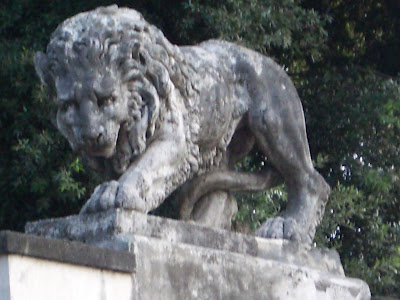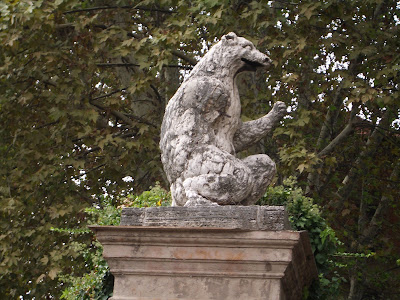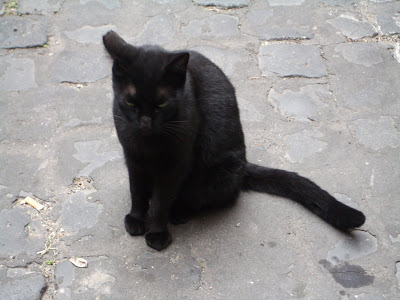Some more picture from Madrid first. This blogging actually takes a long time to do with the picture loading and the thinking up of description on the spot. And I'm not exactly the most creative writer in the world. So you might notice some shorty and choppy text which is when I reach the point that I really don't care for the time being. Oh well.
I went to the Prado Museum and Reina Sofia Museum in Madrid. The Reina Sofia had Salvador Dalí, who after seeing his art is my favorite artist. A self-proclaimed mad man, he painted surrealist art like no others. The images of the melting clocks is him, among others. Here are some of my favorite paintings that I saw. All of these are pictures I took myself zooming in just enough to get rid of the picture frame. They're not perfect pictures but they're good enough. Enjoy and everybody should go to the Reina Sofia Museum...
Besides Dalí, The Reina Sofia has some guy named Picasso (who is not technically a surrealist) and it has other prominent surrealist artists as well, some of which we will see.
First off is the "other" non-surrealish art in the Reina Sofia. Its supposed tor be modern art but I have trouble seeing the artistic value in a lot of stuff because its just cheap stuff you can buy at Big Lots but its displayed with proper lighting and called art. That and just text or newspapers cut out. Art requires skill, and anything that involves newspaper clippings or that retarded paint dripping (like this, the most expensive painting in the world at $140 million) isn't true art. Anybody can do it. But since I know nothing about something as subjective as art I'm probably wrong. You can see Number 5 by Jackson Pollock below. Its expensive because of who painted it (Jackson Pollock was the first to do this art dripping painting stuff like the little kids do) more than the actual painting anyways. But $140 million? Seriously?
First off is the "other" non-surrealish art in the Reina Sofia. Its supposed tor be modern art but I have trouble seeing the artistic value in a lot of stuff because its just cheap stuff you can buy at Big Lots but its displayed with proper lighting and called art. That and just text or newspapers cut out. Art requires skill, and anything that involves newspaper clippings or that retarded paint dripping (like this, the most expensive painting in the world at $140 million) isn't true art. Anybody can do it. But since I know nothing about something as subjective as art I'm probably wrong. You can see Number 5 by Jackson Pollock below. Its expensive because of who painted it (Jackson Pollock was the first to do this art dripping painting stuff like the little kids do) more than the actual painting anyways. But $140 million? Seriously?
Now anyways back to what I actually saw and of my pictures. I saw this "art" of words that start with S shaped in the letter of an S and it was instantly one of my favorites. For me the letter S will always be art so this one is okay in my book.

Yeah I don't really know what these are. The fork on the left has one of its prongs bent oddly and thats it. The other things I have no idea what they mean or their artistic significance.


When I used the color filter on my camera I got this picture. Another cool visual. It would be nice to have this in a room in my future house for no real reason.


I actually don't know what this is called or what it really is but I liked this because of its wavy flow and the use of the color blue which is always a plus. The "waves" of the picture are quite relaxing and the lack of identity in the picture leaves it to the imagination of the viewer.


This is De Este Paraiso by Manuel Millares completed in 1969. The 3-D structure of this work impressed me and I actually liked it even though I have no idea what it is. Can you tell?


Now on to the actual surrealist paintings. This is called A World by Angeles Santos Torroella completed in 1929. In reality its pretty large and taller than me. Its also hard to take in with one glance. I looked at it for a long time and I still had trouble seeing everything that was going on at once. But this is one of my favorites for its creativity and imagination alone.



This is called Bull's Head with Studies for Eyes by Picasso, completed in 1937. He actually had a lot of sketches and pencil drawings like this, which was surprising to me because I thought he only did full paintings.

This is called Monument to the Spainiards who Died for France by Picasso, completed in 1946-1947. I find Picasso difficult to comprehend because he uses a cubist style, but I'm sure he wanted people to feel that way to judge art by all angles at once.


This is called The Witch by Andre Masson, completed in 1942-1943. Apparently the French can paint good surrealist works too. Who knew?













This is one of Picasso' most famous works. You might of seen it. It is pretty big. Security and museum workers were everywhere and lots of people (including me for a little bit) were crowding trying to get pictures. I am of course talking about his work Guernica in 1937. It's too big to fit in one picture in a straight angle from that room so I had to take multiple pictures. The first pic is my best attempt to get the whole thing in one shot even with the weird camera angle. The last two are panorama pics with slight overlaps. Enjoy...



This is El Enigma de Hitler, or The Enigma of Hitler, by Salvador Dalí in 1939. All of Dalí's works are full of personal symbolism. With the help of my internet source, I will actually explain them all. I really liked the Reina Sofia and Dalí particularly. The surrealist art is much more interesting to me than portraits of royal families like in the Louvre or marble statues even because there are so many of those they are like a dime a dozen. As you know, Germany invaded Poland on September 1, 1939 to officially start WWII. Also important to know is that Dalí was a self-described mad man. He was crazy and he knew it. He had visions and lucid dreams and gave everyday objects important symbolic values; all of these are directly in his works.
The only thing I want to say about this is that this is the reason the Surrealist movement kicked out Dalí because he was patronizing the wrong people. And I agree. He truly was a madman.



This work is called El Enigma Sin Fin, or The Endless Enigma completed in 1938. But what does it mean? Well believe it or not, there are six different figures in this painting. They are, in order, "A reclining philosopher; a greyhound lying down; a mythological beast; the face of the great Cyclopean, Cretin; a mandolin; a compotier of fruits and figs on a table; and finally a woman seen from the back mending a sail". And what that means is up to you because I certainly don't know (and the internet doesn't really elaborate). However with Dalí there is no right interpretation of what you see in the real because what you see is truly surreal.

This is The Invisible Man by Dalí, started in 1929 and completed in 1932. This painting is the onset of when Dalí used double images. "The yellow clouds become the man's hair; his lace and upper torso are formed by ruined architecture that is scattered in the landscape and a waterfall creates the vague outline of his legs. As with almost all Dali's work in 1929, this painting deals with his fear of sex. The recurring image of the "jug woman" appears on the left of the picture. To the right of her is an object with a womb shape, part of which delineates the right arm of the man. The dark shape outlining the fingers and legs of the man suggests the female form. Beneath the man a wild beast is prowling - another of Dali's recurring sexual symbols."


Gala, Dalí's wife, lived with him in 1929 and they eventually married in 1934. She was the model and inspiration for many of his paintings, including this 1929 work The Memory of the Woman Child. This one I leave up to you to decide what it means...


This is one of the more famous works by Dalí. It is of course The Face of the Great Masturbator completed in 1929. This painting deals with Dalí's fear of sex, and it is actually a self portrait. The main figure in the painting is Dalí's head, but of course painted in a surrealist and sometimes unrecognizable fashion. Since Dalí had a childhood fear of grasshoppers, the grasshopper under the "body" exemplifies this fear. A woman appears from Dalí's head but the man's legs are cut and bleeding, meaning that he basically a no go. The distant figure in the background is Dalí's father, who from an early age fostered Dalí's sexual fears and frustrations with his graphic book on venereal diseases.
If you can tell that his picture looks slightly different from the other Dalí pictures then you are right. This is Cosmic Composition by Oscar Dominguez, completed in 1938. Oscar Dominguez was labeled a Surrealist before even meeting the group because his style mirrored Dalí. This painting is from his cosmic period phase in 1938-1939, where he painted volcanic structures and bizarre vegetation in barren atmospheres and landscapes.


This painting is Sterile Efforts by Dalí in 1928. This one is left to interpretation as well. Plus I can't really find info about this one online so I'll just let it be.

Near the museums of the Prado and the Reina Sofia is the Royal Gardens. So of course I paid it a visit (it's free) and this is the view from the outside. Well at least one of the views.

Of course I had to take a picture of a cat. This one was kind of scared and ran away easily so I was lucky to get this picture.

This is the typical gardeny scene in the Royal Gardens. There were supposed to be roses in the fields in the background according to the map but they were all wilted and kind of dead due to the winter time. It was mostly just trees, but they had one of each kind of exotic tree from some tree native to Japan to a California Sequoyah tree all next to each other.

Here is a cool picture I took of some tree with some red fruit. I wish I could be more descriptive but I really don't know and because its from the Royal Gardens it could be from anywhere.

Here is a closeup of some tree. The tree itself is actually pretty small though. The after a while I got tired of looking at trees and plants and I got tired. The story continues...

Here is a cool fountain in the park. There are not too many of these but you see some every once in a while. I don't know what creature this is, but maybe you know what it is. I think its someone holding a duck or something like that.

Eventually I got tired and wandered to a park bench and fell asleep. This was my view. Not too shabby. The Royal Gardens are good for a stroll to get away from the city feel of Madrid.

Well that about does it for Madrid. I went out and had sangria on Halloween with some friends on Halloween though, which was pretty fun. They don't really celebrate Halloween in Madrid although I did see some people dressing up in Plaza del Sol. I almost got to go to a Real Madrid game but my hostel couldn't get the tickets for me when they said they would. I also walked all along the streets, including Grand Via which runs horizontally across the city with its center at Plaza del Sol and its western end being Plaza de España. And the western end is where I saw the outdoor restaurant in the plaza (not piazza like in Italy) in the picture above. After spending the Friday, Saturday, and Sunday of Halloween 2009 weekend in Madrid I had an early flight to Barcelona on Monday. I had to check out of my hostel at something like 6am and hop on the metro to go north to the airport. The airport is located outside of the city center so it took a while, but I eventually got there. Nothing crazy with the flight situation (like in London) so eventually I got to Barcelona. Honestly my memory only remembers right when I came from the metro stop in Barcelona at around 1pm that day because my roommate from Rome was waiting for me at our hostel. To be continued...
























